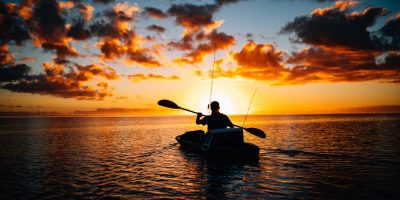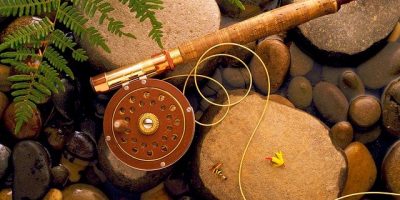At first, you might think you’re going to be limited when it comes to surf fishing because you’re going to be casting out of the dry ground, but this couldn’t be any further from the fact. Aside from deep-sea game fish, you can capture a shockingly large range of fish right off the beach, including Flounder, Rockfish, and Mackerel. This makes it possible for saltwater anglers to catch decent game fish without having to leave the ground at all. Even if you’re saving up for a new boat and a casting platform to get out on the water, you can always get a taste of saltwater fishing and be excited for when you’re about to go out and ground even bigger hits. Here’s a guide to the best saltwater lures for surf fishing!
| Saltwater Surf Fishing Lure | Product Image | Rating | Get It On Amazon! |
|---|---|---|---|
| Spro Bucktail Jig-Pack of 1, White, 3-Ounce | 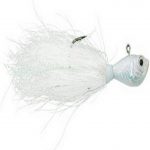 | Check Price | |
| Heddon Super Spook Topwater Fishing Lure for Saltwater and Freshwater | 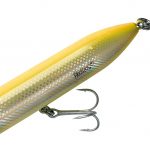 | Check Price | |
| Berkley Gulp! Alive Swimming Mullet Soft Fishing Bait | 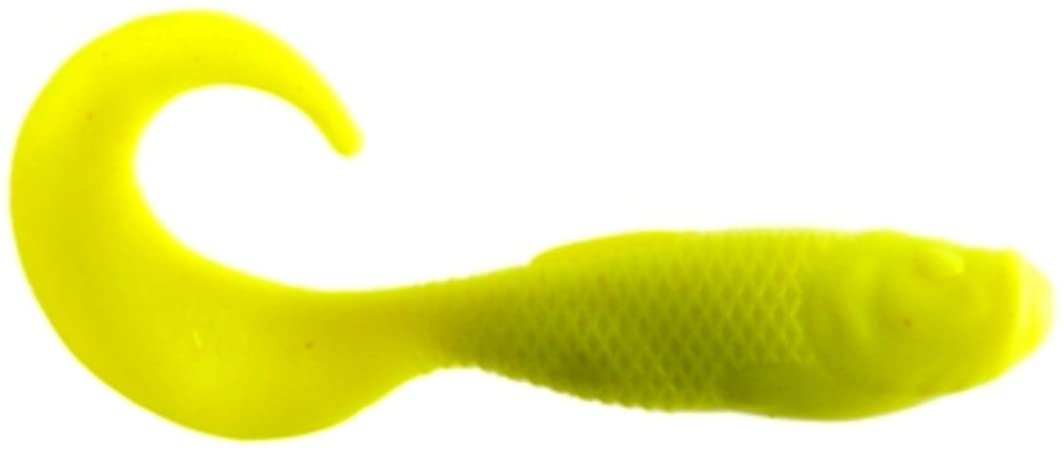 | Check Price |
What Are Saltwater Lures?
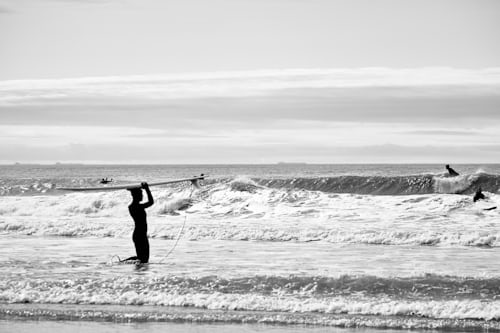
Making lures use softwood or foam or thin sheet metal. If you apply plastic to the top, it produces a bait that sinks under the water’s surface and swims with a “wobbling” rhythm on recovery. Many are homemade, whereas large-scale manufacturing works on robots. Many of the finest surf fishing lures and topwater poppers are handmade.
When Are You Going To Use Saltwater Lures?
If it comes to saltwater fishing, you’ve got to get the best and hardest tools. Your fishing gear has to hold up to the hardest conditions. This is particularly true of saltwater fishing lures. These lures must remain powerful despite violent attacks and hang on to the saltwater itself.
You can use the right saltwater lures to search with large species found in the bay and reef outcrops. Saltwater lures are capable of handling large fish populations and saltwater environments.
How to Pick a Surf Fishing Lure
Know how to do it, but don’t know how to choose? Here’s how it works.
With no exception, surfing is mostly achieved in saltwater. For this cause, it is important that your lures can endure the corrosive quality of seawater.
Many lures will say that they are usable for all water uses, but to be safe, it’s a good idea to shop for a lure designed especially for ocean fishing. This will allow you to stop a commodity that breaks down within a very brief amount of time.
Performance
Since surfing is usually performed from the shore or the pier, it is necessary to move a lure in mind. You’re going to be the driving force in the trap’s acceleration, not with the trolling engine’s aid. Hop to adapt your lure’s behavior to the type of fish you would like to capture. For example, panfish are selective about lure behavior; they are more likely to bite a fast-moving or shimmering lure.
Color
There are so many options when it comes to color tempting. Although there is some controversy over what the pallets are more powerful, go with a lighter color for a bright, sunny day on the beach. Hop to adjust the hue of your future catch to clear water.
Scale
You’ll need to find the right size by thinking just what kind of game fish you’re looking for. Smaller lures measuring an inch or two are ideal for bluegills, perch, and crappies. An inch to three inches is ideally suited for white bass and river trout. Smallmouth bass requires a lure of 2 to 5 inches, whereas size of 2 to 6 inches is suitable for largemouth bass. Wallies need 3 to 6 inches, while lake trout and salmon can be preferred from 3 to 7-inch lures. For northern pike and musks, consider the interest of 4 to 12 inches.
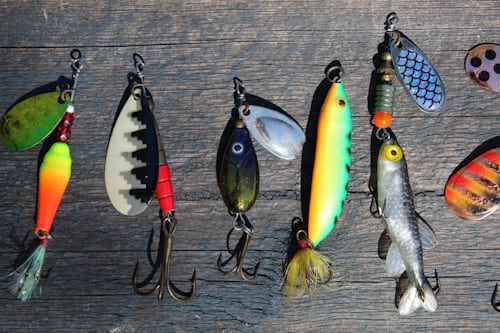
Depth Of The Fishing Area
Many seasoned fishermen know that game fish prefer to go to various locations depending on the season. These spots have varying depths, so you need the best lures for them.
In the summer months, fish prefer to get deeper into the water, so you’ll need fast running lures. In the fall, they migrate to shallower waters. This is also valid in spring when game fish breed and seek food in shallower waters. You would need to use shallow running lures and surface lures instead of these regions.
If you’re chasing northern pike and largemouth bass, you’re going to be fishing all year round in areas with a lot of weeds. To keep your lures from snagging, try to find a weed guard lure. Use surface lures instead to fish under the cover, particularly in the early morning or early evening.
Temperature
Coldwater continues to decrease fish movement dramatically, so you might want to use a smaller lure that you can introduce slowly. The best lures are dick baits and gliders for northern pikes and muskets, preferably with a break in the retrieve.
When the water is wet, the fish become more involved in their reproduction and prefer to eat more often. Now you can use your spinnerbaits, inline spinners, and quick-retrieve crankbaits.
Surf Fishing Lures Styles
There are a few big types of surf fishing lures that are useful for a variety of different reasons. Although the following sections do not cover all the lure types on the market, they are some of the most common.
Metal Spoons
This are super lightweight lures that are designed to throw away long distances. They come in a number of color variations that resemble baitfish and change based on what kind of fish you’re trying to attract.
Poppers
Crafted to appear like a wounded fish on the sea’s surface, poppers are a perfect draw to lure big fish due to their rhythmic motion and the noise they make.
Plastic Jigs
This style of lure is probably the most flexible of all types. They come in a wide range of designs and colors, including one called a bucktail jig, which is included in our list above. They are appealing to many anglers because they can be used for a range of angling events.
Best Saltwater Lures For Surf Fishing
Our Top Pick
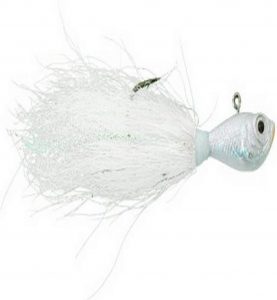
Product Name: Spro Bucktail Jig Lure
Product Description: The classic bucktail jig's simplicity is unmistakable as this little gem will help you capture a snook, a redfish, a fluke, a salmon, and several other fish species. This nifty saltwater lure also helps you capture fish in shallow and deep water, depending on the type of bucktail jig used. These days, this sort of saltwater fishing lure is available in a wide range of colors and designs, allowing you to select the right fit for any occasion.
Brand: SPRO Fishing
SKU: HUYR-92
MPN: B0009V0OL0
Offer price: 5.89
Currency: USD
Availability: InStock
Offer URL: https://amzn.to/30KEvZQ
Valid until: 2025-04-30
-
Durability
-
Ease of Usage
-
Ability To Catch FIsh
-
Color
Overall
There are various types of lures, but depending on the fish you wish to capture, different types of lures will perform best. We choose from top-rated spoons, sticks, poppers, bucktail jigs, and more.
We’ve collected the best saltwater lures for surf fishing, based on criteria such as brand consistency, size, colors, and more. This saltwater lures are ideal for surf fishing and are guaranteed to withstand the harsh surfing conditions.
Several types of saltwater lures are available, such as topwater lures that fit well for areas where fish feed near the shore. Broad saltwater lures to capture trout in shallow waters. Trolling saltwater draws a tow behind a sail. But, for this rundown, we’re concentrating on top-ratedbest saltwater lures for surf fishing—ideal for anglers who want to cast a line from beach, dock, or beach.
Spro Bucktail Jig Lure

The classic bucktail jig’s simplicity is unmistakable as this little gem will help you capture a snook, a redfish, a fluke, a salmon, and several other fish species. This nifty saltwater lure also helps you capture fish in shallow and deep water, depending on the type of bucktail jig used. These days, this sort of saltwater fishing lure is available in a wide range of colors and designs, allowing you to select the right fit for any occasion.
Since not only is the Spro Bucktail Jig available in 15 colors, but it still comes with a really budget-friendly price that actually makes it value-for-money excellent. Don’t be fooled: even though this is one of the cheapest bucktail jigs on the market, it’s still one of the tops valued by other anglers. It is showing that you don’t have to sacrifice on results, to benefit from low prices.
The Spro Bucktail Jig is built to truly ‘come alive’ in the sea. The lure features bulging paws, a special holographic finish, and bright colors that resemble a live fish. Another feature of Spro’s style is that, unlike most bucktails, the pattern is designed to float through the water instead of hanging straight down.
More Information
When jigged, the body is designed to remain almost parallel to the bottom to the top, a perfect, lifelike look. Another factor we score the Spro Bucktail Jig is that it comes with a long-lasting, strong Gamakatsu hook.
We also appreciate that Spro has ensured that this Bucktail Jig is available in several weights, including 1/4-Ounce, 1/2-Ounce, 3/4-Ounce, 3/8-Ounce, 1-Ounce, 1.5-Ounce, 2-Ounce, all the way to the heaviest 6-Ounce range. The lure that better suits your needs often depends on the tides and the kind of fish you expect to capture. If you’re just going to buy one, you can’t go wrong with Spro’s 3/4-Ounce all-white bucktail jig.
Heddon Super Spook Jr Topwater Jerk Bait Lure
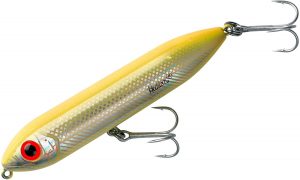
Topwater shit bait lures are perfect for capturing fish using a ‘walk-the-dog’ strategy. If you want to practice this strategy of subtly twitching your reel during recovery, allowing your lure to travel side-by-side, choosing the right bait is the first step to making it right.
The lures made for this technique are long and tapered, kind of like cigars. We have a few personal favorites for walking-the-dog topwater fishing, such as the Yo-Zuri Sashimi Pencil and the XPS Slim Rabbit. But if we’re going to have to recommend some topwater dick bait lure for walking-the-dog fishing, we’d encourage you to get the Heddon Super Spook Jr.
The Heddon Super Spook Jr is the smallest variant of the best-selling Heddon Super Spook. Even if it’s small in size, the Super Spook Jr also boasts the same high-quality, heavy-duty construction and is just as impressive in its ability to catch big fish.
This saltwater lure features durable line ties and hooks to ensure that it can survive explosive fish charges. Though its practical finishes allow it a lifelike appeal to closely imitate live bait in any top-water fishing scenario. The Heddon Super Spook Jr is suitable for all freshwater game fish and is widely recommended by other angling enthusiasts with hundreds of 5-star reviews.
Berkley Gulp Swimming Mullet 12.5OZ Bucket, 4-Inch
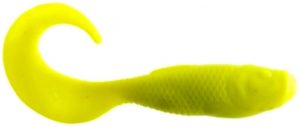
The Berkley Gulp Swimming Mullet comes in the range of fuzzy plastic jigs and lures. This inexpensive draw is celebrated by other anglers as one of the best alternatives to live bait. Not only does this swimming mullet look very natural with a lifelike head and body shape augmented by a high-action swimming tail.
But the lure is also saturated in a potent attractant that extends the strike zone with up to 400 times more fragrance dispersion. Easy and innovative, this highly-rated artificial bait alternative is a clever way to improve your recovery ability!
The Berkley Gulp Mullet is the culmination of 15 years of extensive testing and product growth, exploiting its ability to attract and retain fish. Crafted for use in saltwater fishing environments, this sort of lure is suitable for hooking bass, mullet, trout, perch, fluke, and more. Another major advantage of the Berkley Gulp Mullet is that you can easily reinsert the lure back into the bucket to re-energize it with an enticing, reactivating scent dispersion.
More Information
Other saltwater anglers swear that the Berkley Gulp mullets are successful. They are confirming that it is outstanding both as a key lure and as a preview. There are several rumors that angling enthusiasts claim this is the best saltwater fishing bait, ‘out-fishing’ all other soft plastic lure designs. And this lure’s hundreds of 5-star ratings attest to its success under saltwater conditions.
This is not the longest-lasting piece of saltwater surf fishing bait. The tail of this lure can be easily taken off, or cut, by hostile game fish. And if the tail is down, that’s the opportunity. This means that there’s a risk that you’re going through several mullets every fishing session, making it somewhat less cost-effective.
That said, because of the amount of fish you’re going to draw using the type of special scent dispersion, it maximizes the actual chance of capture. So, if you don’t mind the one-time chance, this could be your latest soft plastic favorite for your upcoming surf fishing adventures.
Frequently Asked Questions
Now that you know the best saltwater lures for surf fishing, here are some answers to questions you might have about best saltwater lures for surf fishing and other surf fishing basics.
What’s the greatest fishing attraction?
The best fishing experience depends on what you’re looking for. If you’re going saltwater, we want a diamond jig, and if you’re going freshwater, some sort of soft lure or trap generally works.
What type of lure is to be used for saltwater fishing?
This depends on the sort of fish you are seeking. Although a lot of saltwater fishing lures work well, live bait, shrimp, or squid is still a good pick.
What lures attract what fish?
Topwater lures (plugs) work for warm water active fish that feed near to the shore, where dive bait works for larger bottom-dwelling fish.
How do you fish using various lures?
Various type lures have various behavior on the angler’s hand to make them appear as authentic as possible. For e.g., a trolling lure would be caught dragging a sail, where a top-water lure would be “tightened” by squeaking movements.
How can you use a fishing lure?
A fishing lure is designed to resemble a victim or a wounded fish. It is important that you “work” your lure in such a way that it imitates the prey or the fish that it is supposed to mimic.
How are you going to use a spoon with a fishing lure?
The ideal action is not to make the spoon spin around on the retrieve, but to have it flicker back and forth without rotating. This slower wobble helps the light to scatter quickly. In the same way, the crippled baitfish wobbles, they don’t move in circles.
How can I jig fish with saltwater?
Throw your jig out of the boat and let it sink to the level you like. A fish will always strike the jig at a fall, but if it’s not reached, then start reeling at different speeds. Depending on the sort of jig, it can execute a gesture that causes a snap. For example, surface iron will be irregular every few seconds, and that’s typically where a bite occurs.
How can you capture saltwater fish from the shore?
Often known as “surf fishing,” You can use live bait or lures depending on the fish you’re fishing with.
How should I fish the spoons?
Spoons come in so many shapes and sizes, and there are so many ways to catch this lure and so many different types of fish that they can consume.
Vertical Jigging is the number one spoon trick most anglers think about when they place this lure in their cabinets. Spoons succeed here, man. No other lure will give you a snap and a flicker of a well-made spoon on a slide, and there’s no fish alive that prevents a wounded-baitfish wobble.
Best Place For Saltwater Surf Fishing
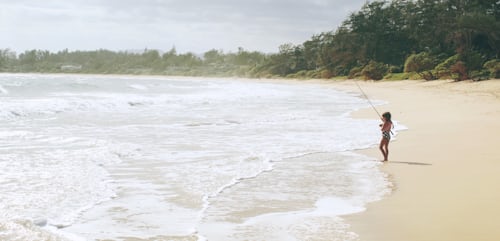
When you’ve got your stick, it’s time to focus on mastering surf fishing fundamentals. Travel to the beach and search for the areas below. If you cannot easily find them, try reading at an up-to-date map, asking a fellow angler, or reviewing the local fishing news. Here are a few tips for surf fishing.
Troughs
Pay attention to where the waves crash off the sand or the sea. The area where the waves stop is usually where you’ll see a dip that runs parallel to the sand. It’s near these troughs where you’ll find current fast-moving areas where baitfish and crustaceans are most frequently found.
You will also see large baitfish populations near the shore in these areas or see a variety of birds flying overhead. Consider using a fish finder rig for species such as flounder, sea trout, bluefish, and pompano in these areas.
Jetties and Breakwaters
Look for jetties or rock formations that stretch into the water and affect the current. Jetties are excellent places to attempt surfing since the rocks below the water are generally home to baitfish and crustaceans that bigger fish prefer to feed on. Wave slams into jetties and breakwaters and creates gaps as the tide recedes and brings sand away from it.
Since the opening is deeper than the ocean bottom, it draws tiny shellfish and baitfish searching for calmer water and a spot to hide. These hiding places are providing ambush sites for predatory game fish. Man-made facilities, such as jetties and brooks, also provide coastal anglers with greater access to shallow waters.
Points
Points are small sand or ground structures that protrude into the ocean to create a current region where game fish can feed baitfish. The current flows past a point will create deeper water areas surrounding deep holes. At low tide, you should drive out to the point and throw out the breakers.
Consider searching for certain holes and bars that might have been missed during the low tide for the rising tide. Be sure to exercise strict caution while surfing fishing points, as fast-moving waves will rapidly drive anglers from shallow water to deep water.
As a guideline, anglers who wade into the sea should always be mindful of the tidal conditions and take a fishing mate wherever possible for safety reasons.
Inlets
Inlets are safe places to catch fish where there are two colliding sources of flowing water or current. Moreover, inlets are also identified by the inclusion of other prominent fishing facilities such as jetties, bridges, sandbars, sloughs, and deep holes. The mixture of density and converging water provides a perfect environment for surf fishing.
Look for rips, bars, or troughs where game fish may normally be waiting for a floating meal in a flowing stream. The fish appear to be stagnant, so it’s better to use bait with a Carolina rig or a jig or plug that goes along with the current to give the fish a realistic appearance.
Are you still looking for a new fishing challenge? If you’ve perfected your saltwater pier and surf fishing skills, it may be a fine idea to get on a little beach boat and try your luck at backwater or shore fishing.
Baitfish Spots
Progress in surfing and shore fishing needs observation. If you can find a baitfish farm, you may be able to capture larger fish that pursue them. But hurry, the game fish will strike quickly and leave. If you’re searching for a baitfish farm, check for gaps or lighter colored circles in bait schools.
Sometimes, if the attacking fish is near the baitfish nest, the bait may maintain a healthy distance on both sides of the larger fish to avoid being consumed. This is what makes the lure schools holes. If you are unable to find these holes, cast your bait or lure on the outer edges of the baitfish schools.
Fish Schools
Baitfish and larger fish schools will swim so close together that they sometimes change the water’s color. Train your eyes to look for these shifting color dots, and you will be praised for your efforts. Step on ahead and let your bait go to school.
Birds
Yeah, believe it or not, the fundamentals of surf fishing require bird watching. Birds are flying over slow-moving baitfish. Get by to try and find out whether the baits are dead or alive. If they’re thrashing about, you should have a shallow trout. If they’re sick, dive faster than that.
Water
Currents will flow down the coast, creating pools of shallow water. Typically this deeper water appears darker than the surface water in the region. Bigger fish will migrate into these shallows to rest or wait for the baitfish to come by. Maybe you’ll get something bigger than you thought.
Breakers
The calmer waters between the location where massive waves fall and calm water begins are called breakers. Crashing waves are forming a kind of depression on the beach. Stuff stays in the pond, baitfish come for stuff, and game fish comes for baitfish. This offers an excellent place for catching fish, but anglers must realize that the fish that come to eat in these areas will eat only quickly in one place and go on to continue looking for food.
Colliding Waves
Underwater currents can converge near points, inlets, or other natural or human-made structures. Where these waves intersect, food can be stored and contained in dense water column locations. The food is going to attract baitfish and then game fish. Don’t look for waves to fall. Look for something a bit more relaxed.
Edges
Healthy surf anglers see various water shades and learn to spot weed beds and other species attached to them. Smaller fish feed on the weeds to catch the fish you’re searching for. You’re going to want to fish around the edges for the best outcomes.
Sea and Beach
Surfing and coastal fishing can be done either from the shore of the bay, from man-made facilities such as jetties and brooks, or from a ferry. Any beach anglers are wading out into the ocean to catch whatever might be hiding beneath the waves.
The only obstacle for coastal fishing is the lack of structure to draw fish, forcing surf anglers to learn how to interpret waves, watch for variations in watercolor, track water temperature, and understand migration patterns.
When To Surf Fish
Saltwater tides and temperature play a vital role in deciding the best hours for surfing trout. Although it is possible to bite fish at any point of the day, the ideal time to surf fish is while the tide is either rising or sinking.
In the hottest months of the year, prepare to go fishing early in the morning or late in the afternoon as the tide goes (up or down). If you’re trying to surf fish during the winter, bear in mind that the days before the cold front will be your best chance to catch a lot of trout.
Where To Surf Fish
If you’re not aware of the right places to fish, don’t think about it. You can surf fish nearly anywhere around the beach or the coast. However, if you take the extra time to pick your fishing spot, it always pays off. States such as Massachusetts, New Jersey, North Carolina, California, Florida, and Texas all offer decent opportunities to capture surf fish.
Surf Fishing Gear
It’s quick to start surfing for beginners with a few surf fishing rods, some natural saltwater bait, and a surf rod and reel combination. The gear you want to use should be based on the target species you wish to capture. You will use the lighter gear and shorter rods with smaller species, whereas larger species may need heavy gear and longer rods.
For example, you may want to use a 7-to 9-foot medium-hard fishing rod for smaller species such as spotted seatrout, bluefish, flounder, or pompano.
Striped bass, red drum, and sharks would need a larger, heavier rod that can support up to 8 ounces of weight and fitted with reels with a high line capacity. For these larger species, use a surf rod that is 12 to 15 feet long with a heavy-duty saltwater spinning reel that has been set up with a 20 to 25-pound thread.
Having the right gear will make your surfing experience smoother and much more fun, particularly when you learn how to read the beach and what conditions are better for hits. Note, knowledge comes from learning. While guides will help set up a base while you practice the art of surfing, truly throwing your rod from the sands of the beach can show you what you need to know to become a professional surf angler.
Surf Casting
Surf fishing is an easy-to-learn form of fishing, with the techniques varying based on variables such as location, seasons, tides, environmental patterns, and the kind of fish you’re hoping to get on the line; but, just starting out, there are clear fundamentals that will get you started on the right track. If you’re new to surf fishing, the first thing you need to do is to learn how to surf the throwing.
Surfcasting is basically a lot like normal casting, but with a greater focus on distance and precision to place your bait on the surf. Generally speaking, you’re going to do fine with a straightforward overhand cast right out.
For an overhand toss, keep the rod in your hand, bend your arm at an angle of 90 degrees, and easily whip out the handle, straightening your arm to throw the lure into the sea. The key to surfcasting is to learn the exact pace and strength you need to improve both the deck’s reach and precision.
Final Words
Ideally, this article will give you a closer look at a tiny part of the world of surf fishing with so many lure choices on the market. Surf fishing lures are the secret to the success of your angling trip, so pick wisely! The best saltwater lures for surf fishing will give you a head start to catch the next trophy fish.

